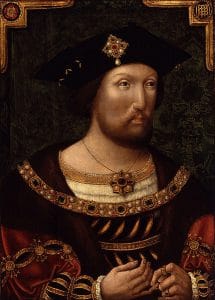 On this day in history, 2nd March 1522, King Henry VIII rode out at the annual Shrovetide joust with the motto Elle mon coeur a navera, or “She has wounded my Heart”, embroidered on the trappings of his horse. Edward Hall records the event in his chronicle and I have modernised the spelling for ease of reading:
On this day in history, 2nd March 1522, King Henry VIII rode out at the annual Shrovetide joust with the motto Elle mon coeur a navera, or “She has wounded my Heart”, embroidered on the trappings of his horse. Edward Hall records the event in his chronicle and I have modernised the spelling for ease of reading:
“In the month of March, as you have heard before, came certain noble men from the Emperor to the king, which the more to solace them enterprised a joust, he himself was chief on the one side, his courser was barded in cloth of silver, of Denmark embroidered with. L. L. L. of Gold, and under the letters a heart of a man wounded, and great rolls of gold with black letters, in which was written, mon nauera, put together it is, ell mon ceur a nauera, she hath wounded my harte, and the same suite was his base.
Then followed Sir Nicolas Carewe, his base and bard was white Damask, on which was embroidered with Cloth of gold: a prison and a man looking out at a grate, and over the prison came from the prisoner a roll, in which was written in French, “in prison I am at liberty, and at liberty I am in prison”, and all his apparel was guarded with shackles of silver.
Then followed the Earl of Devonshire, the Lord Roos in one suit, their apparel was white velvet, embroidered with cloth of gold, wrought in device a heart, traversed crosswise with a chain, the which divided the bard in four quarters, in two quarters was a hand of gold holding a spear of the world, on the other two quarters was two hands
holding two plumes of feathers, and on the borders were written “my heart is between joy and pain”.
Then followed Anthony Kingston, and Anthony Knivet, their apparel was a heart bound in a blue lace, embroidered on crimson satin: and written about with letters of gold, “my heart is bound”.
Nicholas Darrel had a bard and base of black satin, embroidered full of hearts, turned or broken of gold, and written in letters of silver, “my heart is broken”.
Last of that band was Anthony Brown, which had a bard of silver full of spears of the world broken, set on hearts broken all of gold written about in letters of black sance remedy, “without remedy”.
Then entered the Duke of Suffolk and his band, all in bards and bases of russet velvet and cloth of silver, embroidered with branches of paunces (?) of gold, at these jousts were many spears broken, which the strangers highly commended.”
It is often said that Henry VIII’s use of this motto and the Shrovetide theme of unrequited love is evidence of his courtship of Mary Boleyn, sister of Anne Boleyn, but there is actually no evidence that it was aimed at Mary. The motto could have been aimed at another woman that had caught the king’s eye or it may not have been aimed at anyone at all. Click here to read more about Mary Boleyn and her relationship with Henry VIII.
Three days later, Shrove Tuesday was celebrated with a special pageant, “The Château Vert”, at York Place. Mary Boleyn and Anne Boleyn both played parts in that pageant – see 4 March 1522 – Anne Boleyn and the Chateau Vert Pageant.
Notes and Sources
- Hall, Edward. Hall’s chronicle: containing the history of England, during the reign of Henry the Fourth, and the succeeding monarchs, to the end of the reign of Henry the Eighth, in which are particularly described the manners and customs of those periods. Carefully collated with the editions of 1548 and 1550, Printed for J Johnson, 1809, p. 630-631.